Pesto di Basilico (Basil Pesto)
Pesto di Basilico. Better known as Basil Pesto, this iconic Italian sauce has been around forever. Pesto is so easy to make, there really is no reason to buy it pre-made when you can do it yourself. In this post, I’ll show you how to make a fresh and easy pesto that is great on almost everything!
Basil Pesto (Pesto di Basilico)
What is Pesto di Basilico? In the Italian language, it means basil pesto. In English, it translates to pesto of basil. This fresh and bright green sauce is loved the world over. Sweet basil, pine nuts, salty parmesan, garlic, and olive oil combine to make a truly special condiment that is pasta’s best friend (it’s pretty great with other things too).
I am lucky enough (hopefully you are too) that my local grocery stores sells basil year round, so I don’t have to wait for it to be in season!
While I am a big advocate for cooking in season, I am also an advocate for just using things fresh whenever possible. So I say don’t wait for fresh basil season. Have some whenever you can find it in the store. Or, if you are able to grow it year round at home, do that!
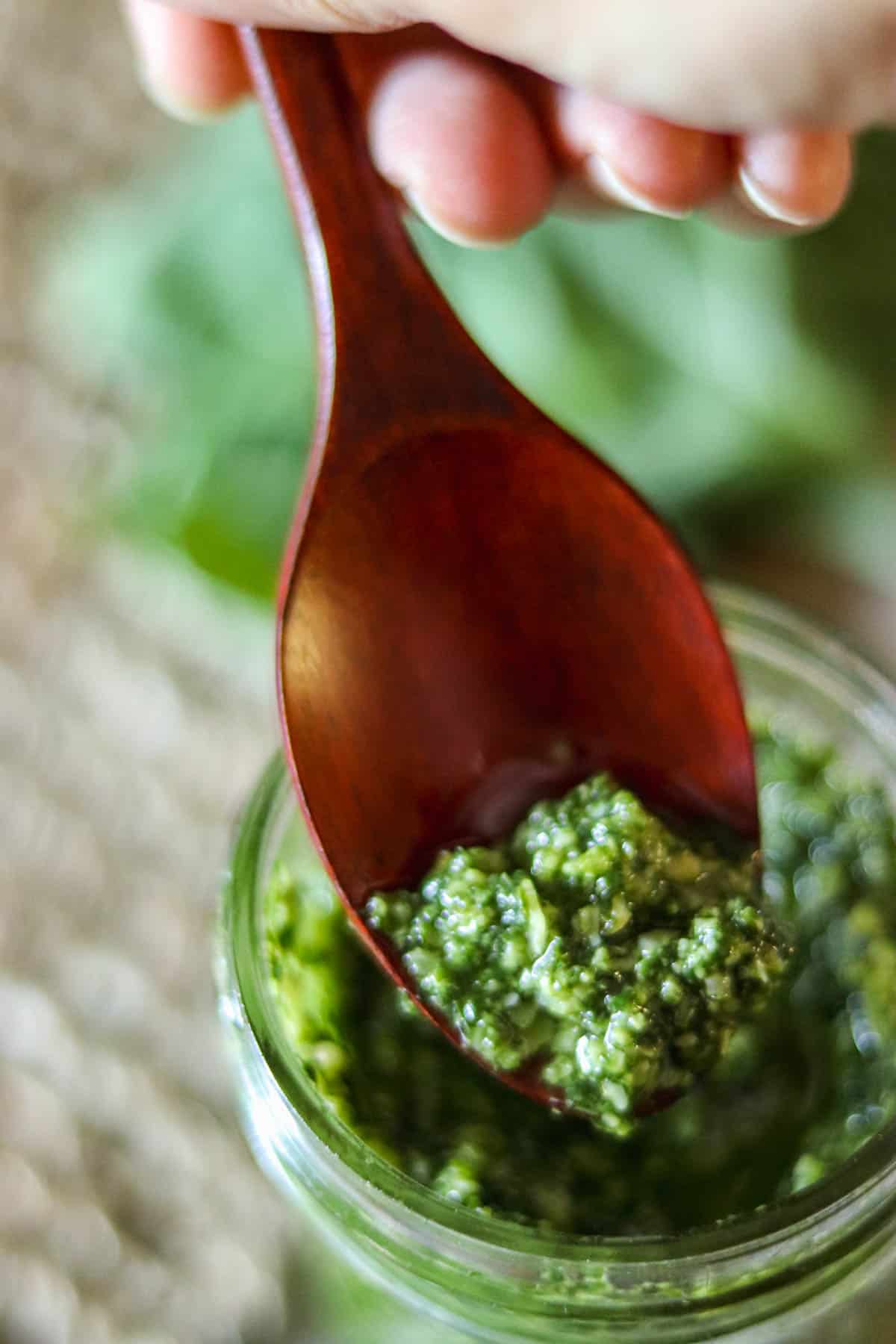
What You’ll Love About This Recipe
If you garden and grow your own basil, this recipe will be extremely useful! I can’t think of a better way to use up massive amounts of basil than this recipe right here. I have included helpful photos to give you a visual of what’s involved. As you can see from the photos this is pretty easy!
This pesto will add so much freshness and bright flavor to all your dishes, however you decide to use it.
Pesto adds a beautiful color, freshness, and brightness to anything it touches. This recipe is so easy, you will probably never buy store bought again!
History of Pesto di Basilico
Pesto is centuries old, having originated around the 16th century in the Genoa region of Italy. Pesto made with basil is the traditional way pesto was first made. There are many other types of pesto out there, but Pesto di Basilico is the original.
They didn’t have the equipment back then that we do today. Until food processors came along, pesto was made using a mortar and pestle to grind the nuts and the cheese, then adding the basil.
It was a slow process that was a bit labor intensive. The documentary Salt Fat Acid Heat with Samin Nosrat on Netflix gives a great demonstration of this technique. If you haven’t watched it, it’s really interesting!
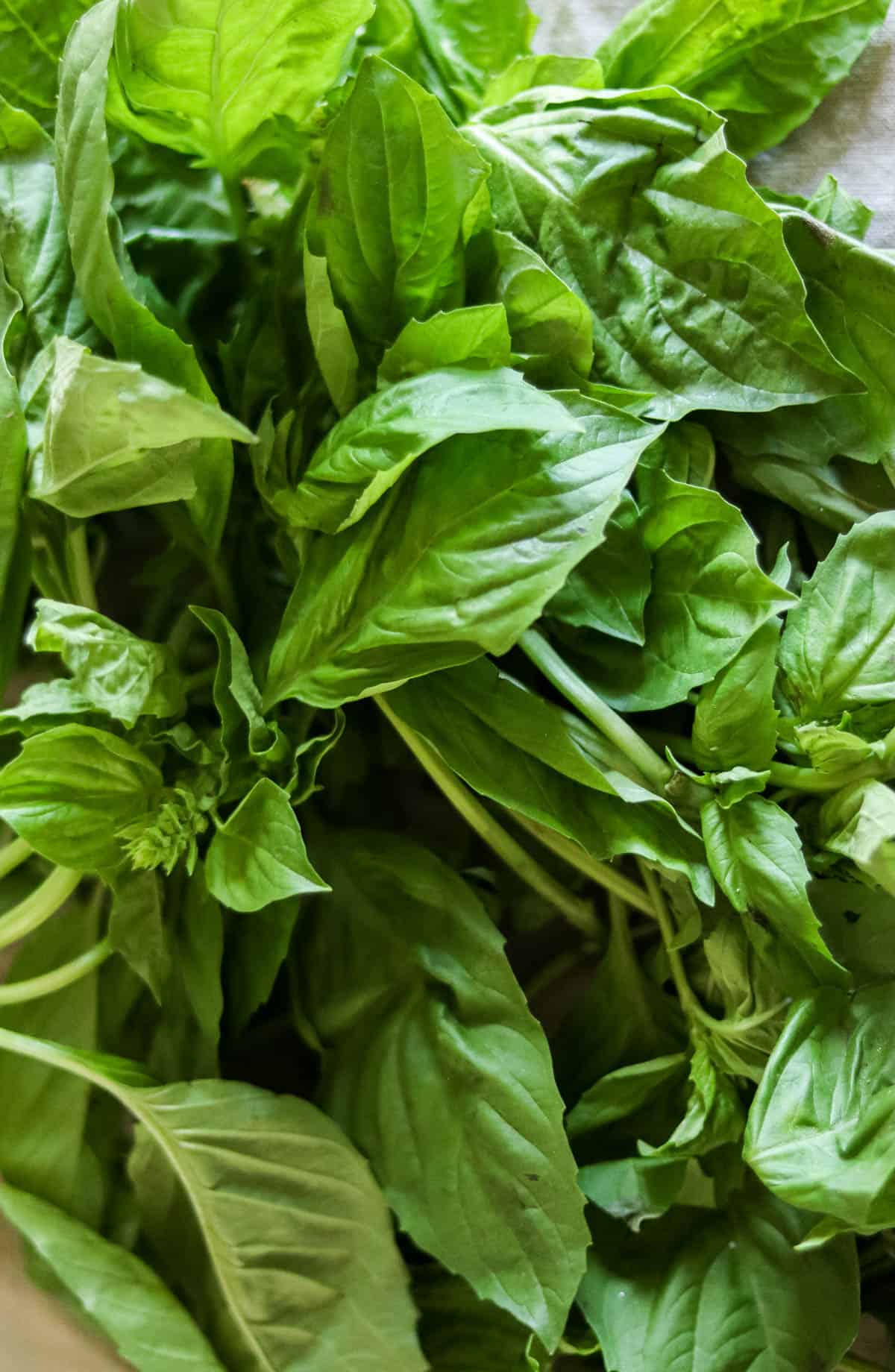
Ingredients Needed
Pesto is a fabulous example of the magic that happens when you combine a few flavorful ingredients.
Fresh Genovese Basil– Genovese is the most common variety used to make Pesto di Basilico. It is most likely the type you will find at your grocery store or Farmers Market.
Olive Oil– I used Extra Virgin for this recipe, but I have found that there is not a significant flavor difference if you use Light Olive Oil or another variety.
Pine Nuts– You can use another type of nut if you can’t find pine nuts (more on that below) but they are traditionally the variety used. You can toast them a little to add extra flavor by putting them in a non stick skillet on medium heat for 3 50 5 minutes, until they smell toasty and are golden. Just be careful not to burn them!
Fresh Garlic– All you need to do is peel your garlic and the food processor will do the rest. Choose garlic that is firm and does not have shoots growing from the top. If you are in the right season for garlic scapes and want to experiment, you can try substituting the garlic clove for 1 Tbsp of chopped garlic scape. For more on garlic scapes, check out my Guide to Scapes.
Parmesan Cheese– Parmesano Reggiano would be ideal here, but if you can’t find it, try to use something that you grate yourself instead of using pre grated parmesan.
Salt and Pepper– You won’t need a lot, just enough for seasoning.
That’s it! So simple and flavorful as well as super versatile.
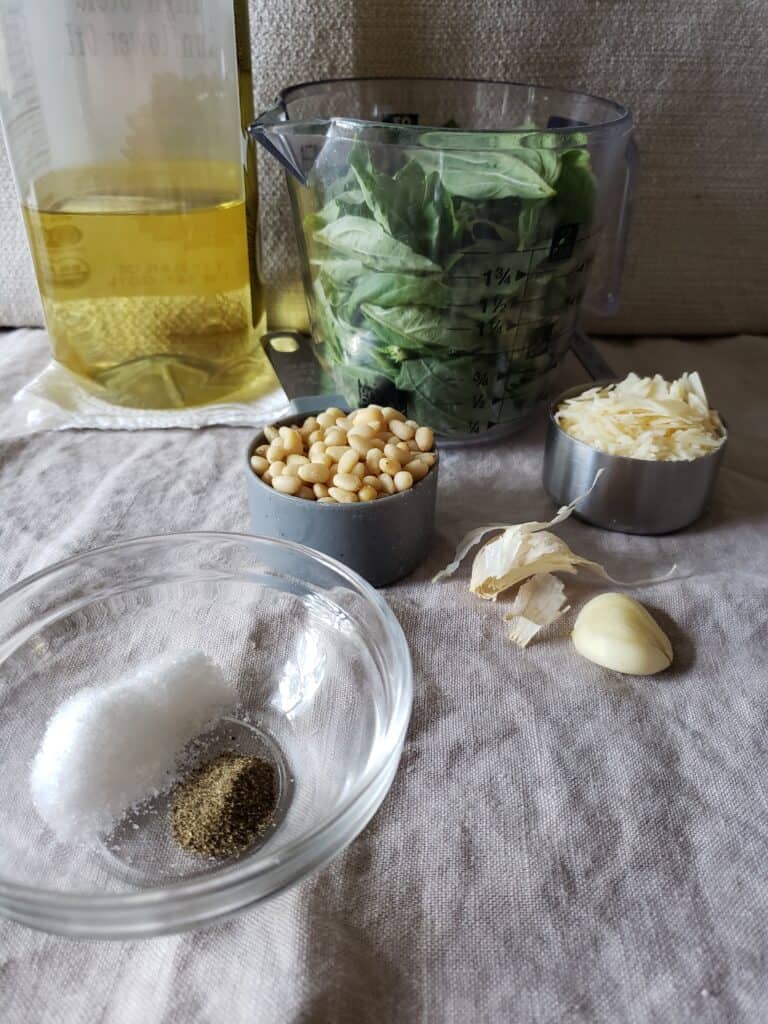
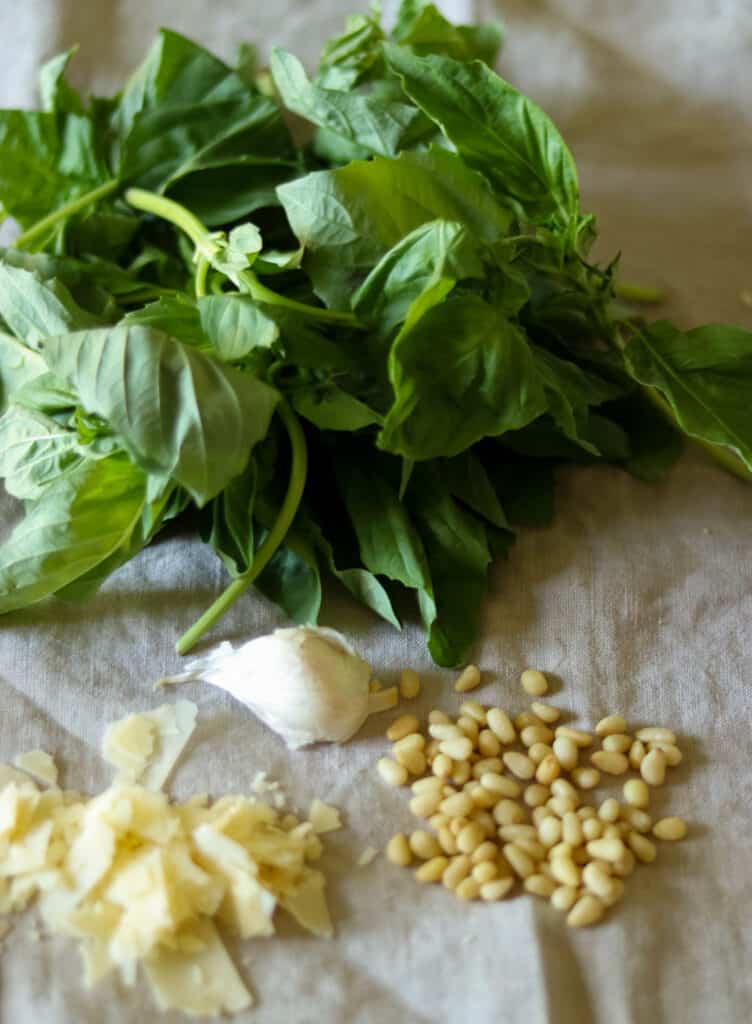
How To Make Basil Pesto
This is as easy as 1-2-3. add your ingredients into a food processor and run until well blended. That’s just a basic overview, there is more detailed info in the recipe card below.
In my opinion, there is no “correct” way to process pesto. I have tried adding one or two ingredients at a time, and even putting everything in the food processor all at once and have really seen no difference in how the finished product turns out.
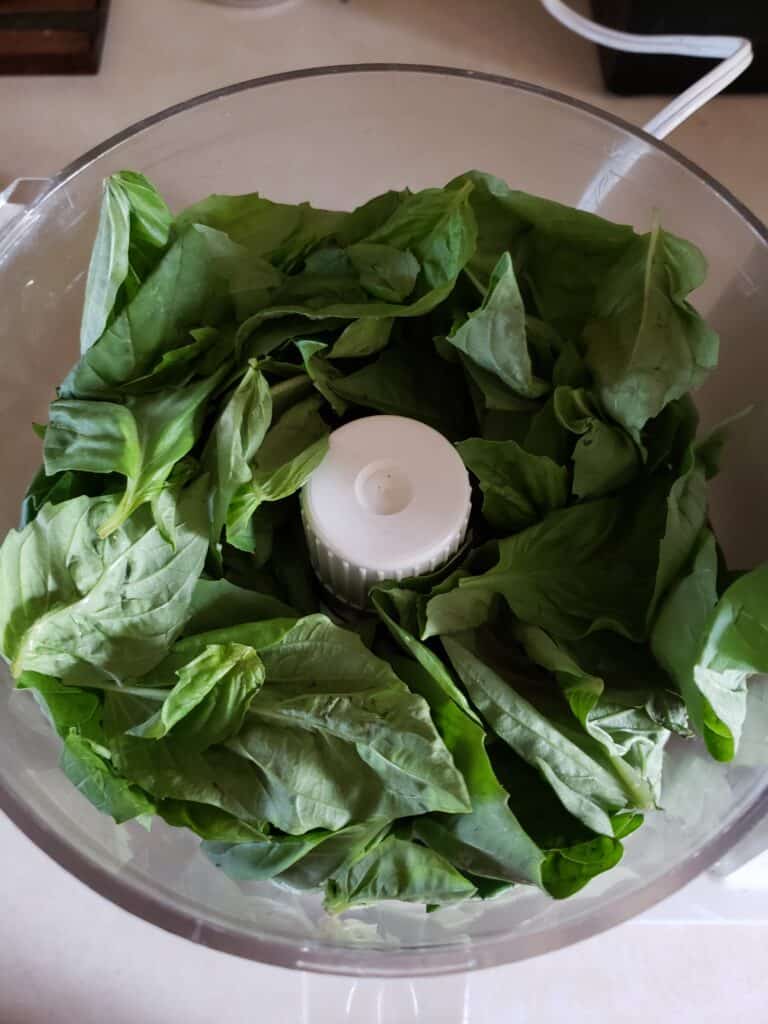
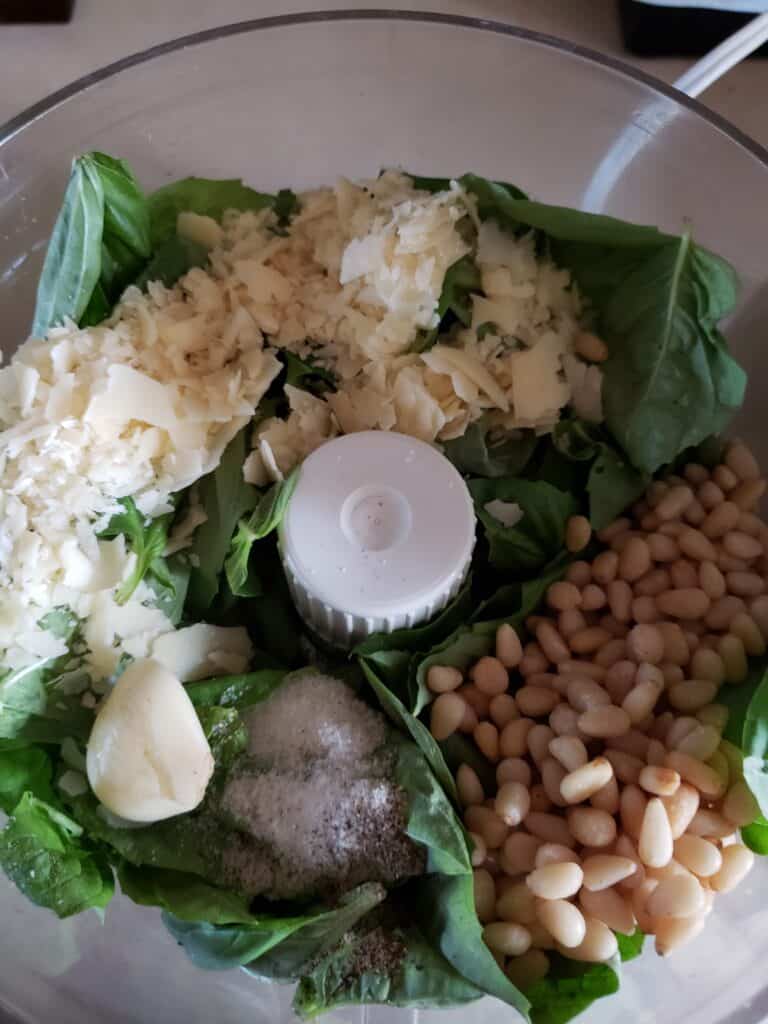
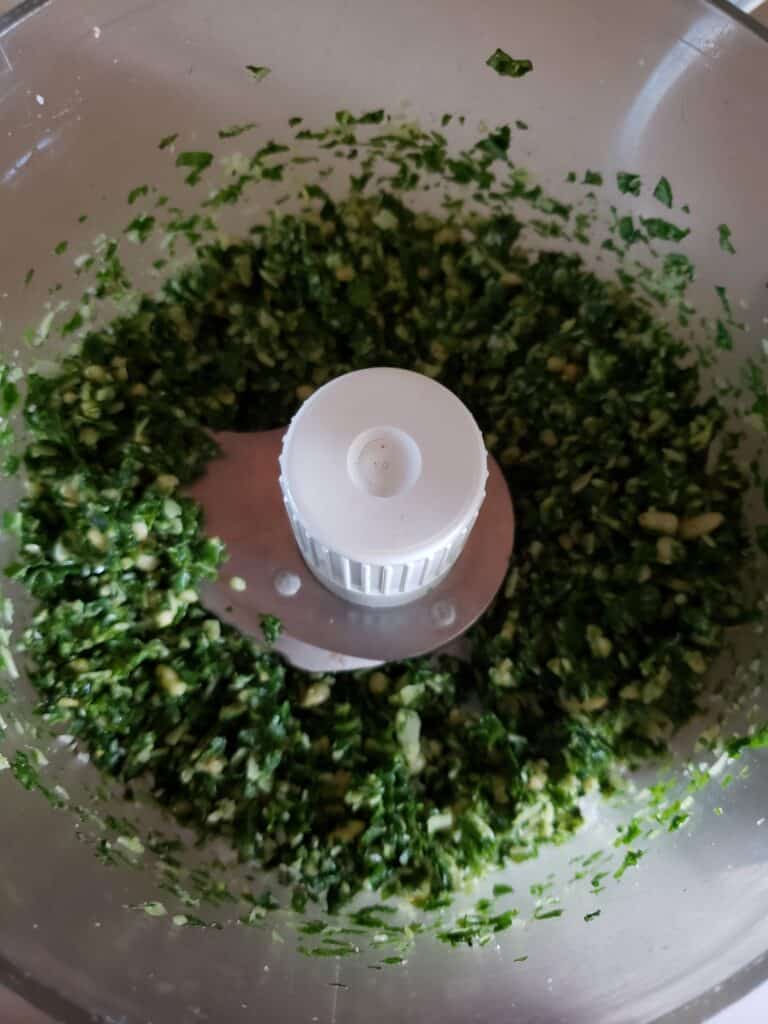
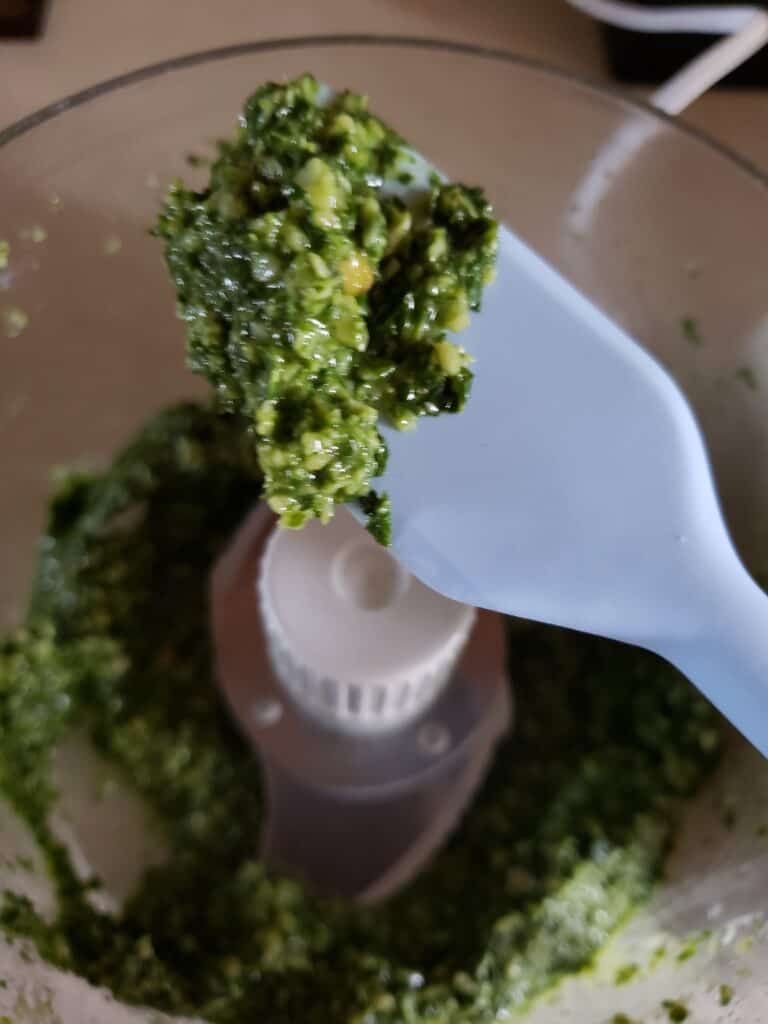
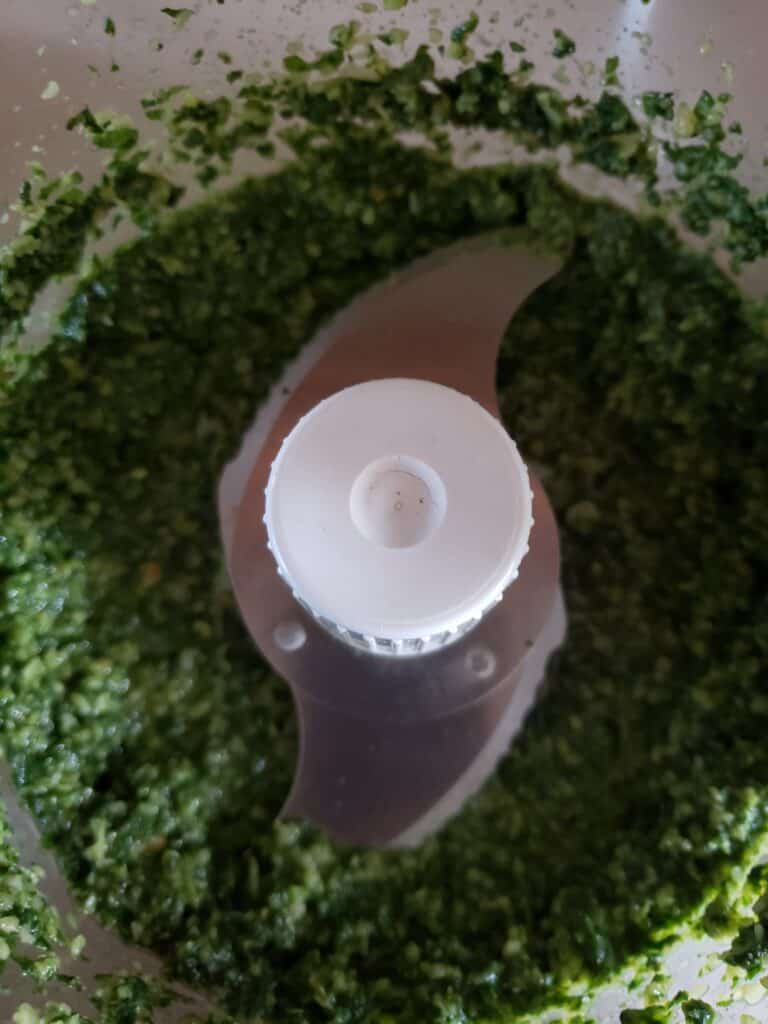
Equipment Needed For This Recipe
Unless you’re feeling ambitious and want to go the mortar and pestle route, you’ll need a food processor. They are honestly great for so many things it is worth buying one if you don’t have one already.
All you really need are three things:
- Food Processor
- Rubber Scraper (for getting the pesto out of the food processor bowl)
- Jar or other container for storing the pesto
Try to make sure your food processor has around a 4 cup capacity so that it is not overcrowded. This makes for smoother pesto. Also, the bigger the food processor, the easier it is to make a larger batch of this recipe!
Can I Use Another Variety Of Basil For This Recipe?
You can, there are many varieties out there. They don’t all taste the same, so be aware that if you use a variety other than Genovese basil that it may not have quite the same flavor you are used to.
What Could I Use If I Can’t Find Pine Nuts?
I happen to like walnuts as an alternative (just make sure they are unsalted) if you have a nut allergy, try sunflower seeds or pumpkin seeds (again, make sure they are unsalted).
Can I Substitute Another Cheese For The Parmesan?
Yes! You could try Romano or Grana Padano. Just be sure it is a hard cheese, you wouldn’t want to use something that melts like mozzarella.
Can You Freeze Pesto?
Yes you can! To do this, scoop it into ice cube trays to freeze, then transfer the cubes into freezer bags to store long term. I recommend using frozen pesto within a month. To defrost, pull out a freezer bag with pesto cubes and allow them to defrost in the refrigerator.
How To Serve Pesto di Basilico
Where do I start? There are so many possibilities! Pesto is one of the most versatile condiments you will ever run across. I love it with most anything, and if you have only used it on pasta up until now, give one of these ideas a try!
- Tossed with pasta or garlic scape ravioli
- Stirred into Mayonnaise for a sandwich
- Pizza base (alternative to tomato sauce)
- Tortellini or ravioli filling
- Salad Dressing
- Dip for bread
- Mix with butter to put on meat (like my pesto butter salmon)
- Topping for grilled chicken or salmon
- Drizzle over pizza
- Frittata Topping (it’s great on my zucchini mushroom frittata)
- Stir into hummus, polenta, or risotto
- Use in potato salad instead of a mayonnaise based dressing
- Toss with baby potatoes before or after roasting
- Stir into roasted shrimp or serve over cooked scallops
- Add a spoonful to polenta
Those are just a few suggestions. The sky is the limit when it comes to pesto! I hope this is a recipe you’ll make over and over, and that it becomes a kitchen staple. I always seem to have a jar of pesto around, and it never fails to brighten up a dish.
For other pesto ideas, check out these posts:
- Roasted Rainbow Carrots with Carrot Top Pesto
- Pumpkin Lasagna with Kale, Chard, and Pecan Pesto
- Pesto Calabrese
I love adding a small spoonful of this to the sauce for my Rigatoni Primavera, it adds a nice pop when I want to change it up.
Before serving, allow it to come to room temperature before using. If it seems thick, stir in a little additional oil to help thin it a bit.
How To Store Pesto
This will keep in a jar with a tight fitting lid or a plastic tub with a lid. To keep it from browning, add a thin layer of additional oil to the top of the pesto to protect the surface.
If you are reading this, thank you for being here. I certainly hope you love this dish! If you tried this recipe for Pesto di Basilico, I’d love to hear how it turned out! Just leave a rating or comment below.
If you’d like to share this recipe with friends, I have some ideas to help you do just that!
Make this recipe and take a picture and tag me @thecoppertable in a post on Instagram.
You can also pin to a sauces, pasta, Italian Food, or other board you have on Pinterest to save this recipe for future reference.
If you’re not on Pinterest and still want to share, you can share on Facebook, Twitter, or anywhere else you like!
Have you signed up for my email newsletter? If not, you can do that below. I have all sorts of exclusive content just for newsletter subscribers as well as a free ebook, and I’d love for you to join. Happy Cooking!
Print
Pesto di Basilico
This easy Pesto di Basilico is versatile, fresh, and so delicious. It's great on almost anything!
- Total Time: 10 minutes
- Yield: 4 Servings 1x
Ingredients
- 2 cups Fresh Genovese Basil Leaves, tightly packed
- 1/4 cup Pine Nuts
- 1/4 cup Parmesano Reggiano cheese, grated or shredded
- 1 clove Garlic
- 1/2 tsp Salt
- 1/4 tsp Black Pepper
- 1/4 –1/3 cup Olive Oil
Instructions
- Pack the basil leaves in a two cup measuring cup. Make sure they are tightly packed in the measuring cup.
- Remove the basil leaves from the measuring cup. Tear the stems off the leaves and roughly chop them.
- Peel the garlic clove and grate or shred the Parmesan cheese until you have the 1/4 cup needed (if it is not already shredded).
- Place the fresh basil leaves in the bowl of the food processor.
- Next, add the 1/4 cup pine nuts, the 1/4 cup parmesan, clove of garlic, the 1/4 tsp of salt, and the 1/2 tsp of black pepper to the food processor bowl.
- Pulse a few times to grind everything up.
- Starting with 1/4 cup, add the olive oil to the food processor. You can do this while it is still running or turn it off to add the oil if you prefer.
- Process until everything looks smooth. Turn off the food processor and stir the pesto with a rubber scraper. If it seems too thick, add a little more olive oil one tablespoon at a time until the sauce reaches the right consistency. You don't want it too thick, but not too oily either.
- Turn off the food processor and stir with the rubber scraper again to check for any pine nuts that are left whole. Process again and keep checking until everything is ground up. This won't take long. You may only need to process one more time, or you may not need to at all.
Notes
Genovese basil is the best variety to use for this recipe.
If you don't have any olive oil you can use sunflower seed or avocado.
Romano or Grana Padano can be substituted for the Parmesan.
This recipe yields about 1 to 1 1/4 cup of pesto.
If you prefer, you may choose to add the pine nuts and cheese to the food processor first to grind them up and then add the remaining ingredients and process until smooth.
- Prep Time: 10 minutes
- Additional Time: 0 hours
- Cook Time: 0 hours
- Category: Sauces and Condiments
- Cuisine: Italian
Nutrition
- Serving Size: 1
- Calories: 161
- Sugar: 0
- Sodium: 327
- Fat: 15
- Saturated Fat: 4
- Unsaturated Fat: 10
- Trans Fat: 0
- Carbohydrates: 3
- Fiber: 1
- Protein: 5
- Cholesterol: 13

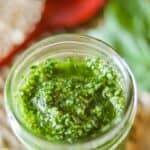




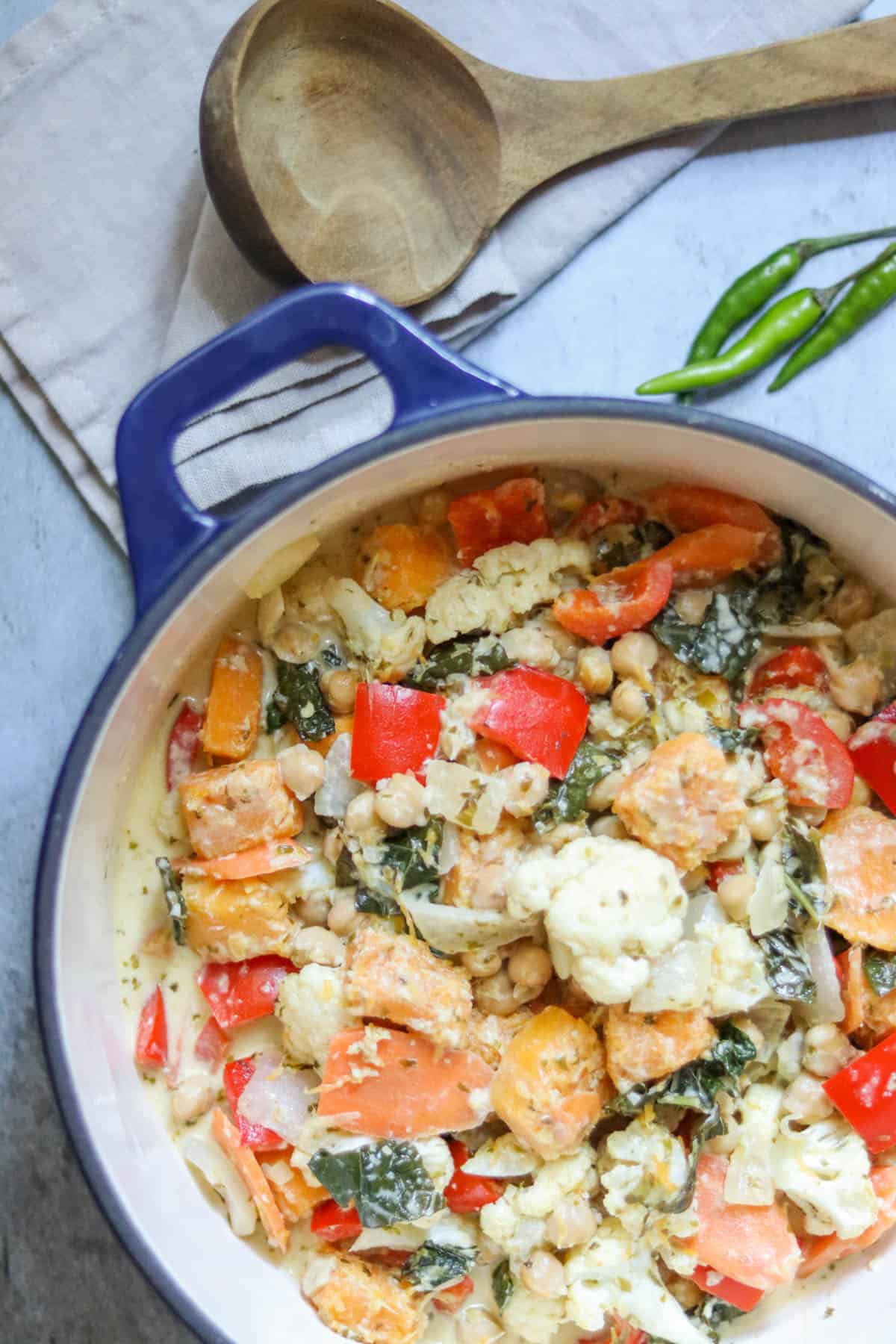

Your recipe for Pesto di Basilico is a true celebration of the simplicity and freshness of basil. It’s amazing how a handful of ingredients can come together to create such a flavorful and versatile sauce. The step-by-step instructions and your personal touch in sharing your Italian heritage make this recipe even more special.
Thank you Sandra! I am so glad you stopped by, and I hope you enjoy this recipe!
I loved Salt Fat Acid Heat! It teaches a lot about the principles of cooking, which is why it’s useful to watch it! Anyway, for the pine nuts those can get pricey. But I found walnuts (like you), can do the same. They have that same softness to them without a strong taste. Never thought of trying sunflower seeds… may need to give that a try. You can also blend in a bit of kale just to give it some added nutrition and bulkiness. Also try nutritional yeast instead of parmesan for a vegan option.
Visiting again from the Homestead Blog Hop! Thanks again for sharing your recipe!
Laurie
Pesto is the whole reason I plant basil! I need to get out there and harvest come before it flowers and make our pesto!
Thanks for the reminder! Also thank you for sharing your recipe at the Sunday Sunshine Blog Hop 73! Your post will be featured at this week’s blog hop!
Congratulations!
Laurie
Thank you for the feature Laurie! I love making my own pesto!
I need to make this. I have two very large basil plants!! Thanks for sharing at the What’s for Dinner party. Have a fantastic week!
Pesto is really the best thing for all that extra basil!
It looks perfect and the photos are beautiful. Thank you for sharing.
You are welcome!
Looks delicious! I’ll be featuring your post on tomorrow’s You’re the Star. Thanks for sharing with us!
You are most welcome Niki! Thank you for the feature!
Thank you for sharing this very interesting and informative information about making pesto. My basil plant is screaming for me to use it for something, and you gave me all the info I need to get going on my project. Your suggestions for uses of the pesto are also wonderful sounding. Thanks so much! You have made my mouth water. Smiles, Linda at Paper Seedlings
You are so welcome Linda! I’m glad the info was helpful and I hope you enjoy your pesto!
This is a wonderfully simple pesto recipe – and bursting with the fresh flavors! A perfect pesto for pasta, crostinis, even scrambled eggs!! Delicious!
Happy to hear that you love it Helen!